Clash of the Titans - TT Tai Chi vs. CM Stacker 830
by Joshua Buss on February 23, 2006 12:05 AM EST- Posted in
- Cases/Cooling/PSUs
Cooler Master Stacker 830 (cont’d)
The last aspect of the 830 that needs to be addressed is its ability to morph into a BTX compatible system. In showing how this is possible, we'll also highlight some of the other fine details of this complex case. It all basically comes down to a very well designed motherboard tray. Notice how thumbscrews are used instead of problematic plastic clips to hold expansion cards down.
Since the main difference between ATX and BTX systems is the orientation of the expansion cards in relation to the I/O ports, those two components of the rear plate of the motherboard tray are separate, and can be put back into the tray reversed.
After removing a total of six screws, the two panes of the back hinged right off. Once off, they can be attached to each other in reverse – exactly how BTX motherboards are laid out.
After assembling the motherboard tray in its reversed configuration, the tray is slid into the opposite set of rails in the case. Next comes the fan juggling.
The fans, fan cages, and fan grills are all interchangeable on the Stacker 830. The unit on the far left is a fan in its cage, the unit in the center adds the grill, and the unit on the right is simply an empty cage with grill. Each of these are needed in various places, but generally, the unit on the far left goes at the rear or top of the case, the unit in the center goes at the front if one wants additional air to be brought in at the front, and the unit at the far right is a passive vent that fits in front of the BTX duct.
In this shot for instance, three of the standard bay place-holders have been removed in favor of the single cage and cover unit. In the bays themselves, one may install the BTX duct to direct air appropriately in terms of the BTX specification.
Lastly, here are a couple of shots of the lighting of the case. In a completely dark room, a well-loaded 830 can put on quite a show.
And the aforementioned power button:
The last aspect of the 830 that needs to be addressed is its ability to morph into a BTX compatible system. In showing how this is possible, we'll also highlight some of the other fine details of this complex case. It all basically comes down to a very well designed motherboard tray. Notice how thumbscrews are used instead of problematic plastic clips to hold expansion cards down.
Since the main difference between ATX and BTX systems is the orientation of the expansion cards in relation to the I/O ports, those two components of the rear plate of the motherboard tray are separate, and can be put back into the tray reversed.
After removing a total of six screws, the two panes of the back hinged right off. Once off, they can be attached to each other in reverse – exactly how BTX motherboards are laid out.
After assembling the motherboard tray in its reversed configuration, the tray is slid into the opposite set of rails in the case. Next comes the fan juggling.
The fans, fan cages, and fan grills are all interchangeable on the Stacker 830. The unit on the far left is a fan in its cage, the unit in the center adds the grill, and the unit on the right is simply an empty cage with grill. Each of these are needed in various places, but generally, the unit on the far left goes at the rear or top of the case, the unit in the center goes at the front if one wants additional air to be brought in at the front, and the unit at the far right is a passive vent that fits in front of the BTX duct.
In this shot for instance, three of the standard bay place-holders have been removed in favor of the single cage and cover unit. In the bays themselves, one may install the BTX duct to direct air appropriately in terms of the BTX specification.
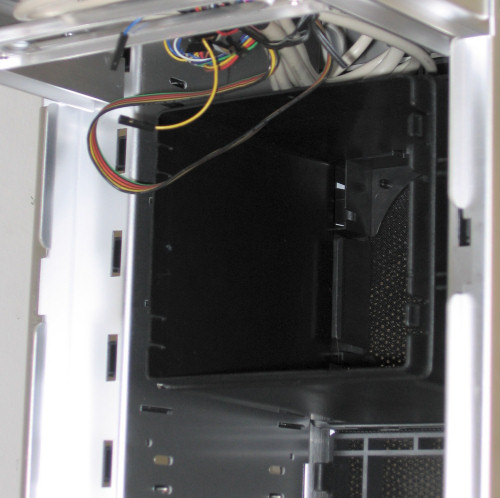
Lastly, here are a couple of shots of the lighting of the case. In a completely dark room, a well-loaded 830 can put on quite a show.
And the aforementioned power button:
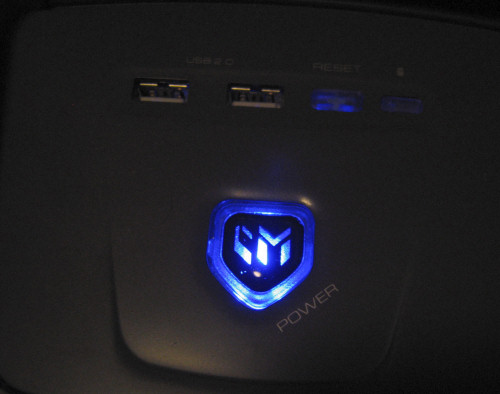


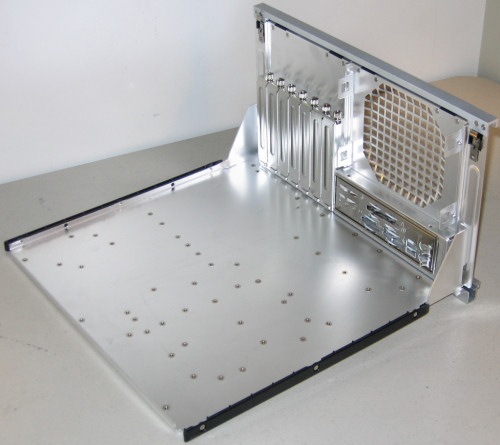
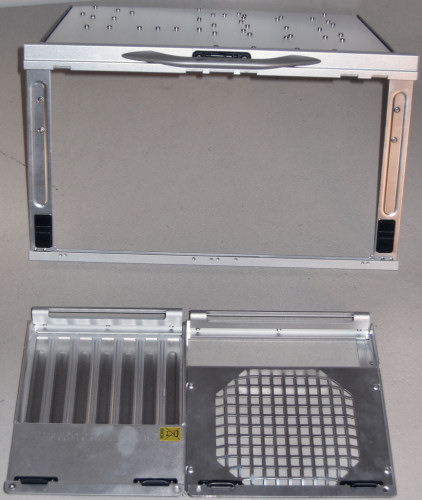
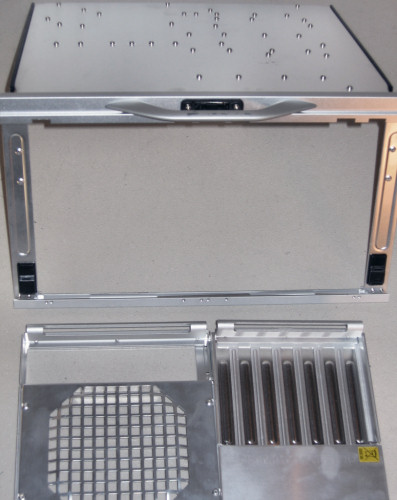
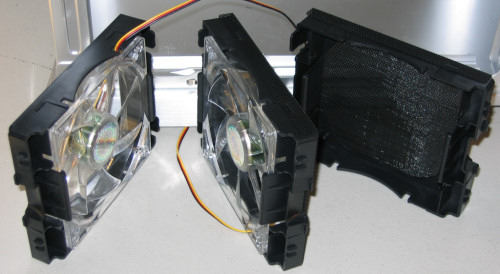
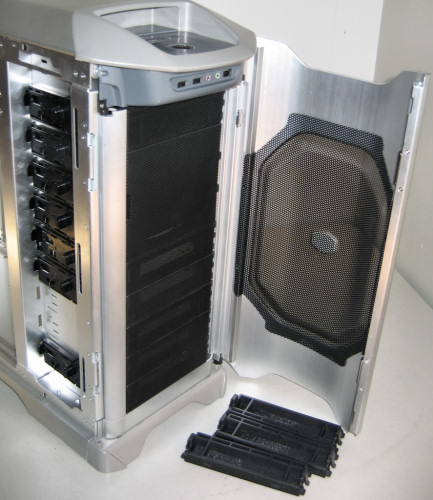
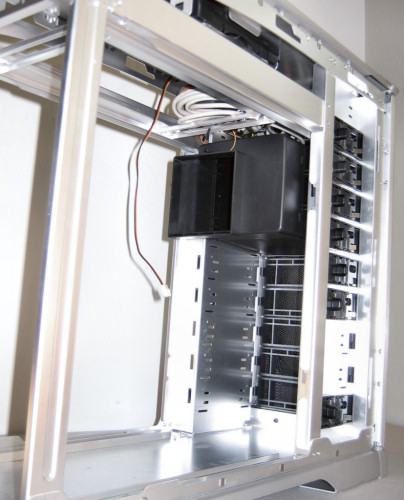









55 Comments
View All Comments
JoshuaBuss - Sunday, February 26, 2006 - link
The stacker 830 would probably be a perfect case for someone like you.. it has the potential for an incredible amount of air flow right at the hard drives and video cardstjr508 - Friday, February 24, 2006 - link
This article states the front bay pannes on the CM case are held in loosely. I find that strange being my $50 CM case (awsome case) actually uses screws to hold these in place, making them the most secure that I have ever seen. I wonder why CM felt it important to secure these tightly on their $50 cases but not on their $250 case?chynn - Thursday, March 2, 2006 - link
Wrong! What Anandtech did not do with the RC-830 was to lock the 4to3 drive bays down with the provided screws. The snap locks are there only to position the drive bays, and anything else, that fit into the 5.25in slots.Only the Lian-Li V1000 and V1200 cases, in my experience, have a fool-proof and moron-tolerant hard drive locking mechanism.
JoshuaBuss - Monday, May 15, 2006 - link
I was referring to the pop-out panels that cover unused 5 1/4" drive bays. They're very loose, and there's no screws for holding them in place.BikeDude - Friday, February 24, 2006 - link
I have been using the Armor case for almost a year, and the green plastic clips still gives me nightmares.If you get impatient, they'll simply detach and you'll have to nudge them back in again. In practice, I've wasted a lot of time nursing cards underneath the clips, reattaching the clips and finally pray it all fits in the end.
Even a simple old-school phillipshead screw would've saved me _a lot_ of time!
It is disheartening to see that TT not only makes mistakes, but insist on repeating them. :(
Also, the four holes for watercooling, on my Armor case atleast, are positioned too close. Atleast when attaching the Zalman Reserator-1 system. With the reserator you can choose to have a junction there so that you can more easily detach the cooler and move the case... Won't work if you have two Reserators...
Tamale - Friday, February 24, 2006 - link
Interesting point about the reserators.. what's the junction exactly?As for the green clips, I tend to agree.. it's a shame they didn't come up with a solution as elegant as the thumbscrews used to hold the 5 1/4" drives.. but for the majority of cards they do work very nicely.
theoak - Friday, February 24, 2006 - link
The reviewer calls this a tie.If keeping your components cool is the objective, I feel that the 830 wins by a landslide.
If you look neer the end of the review at the heat comparison chart, the 830 wins or ties all but two (HDD and System Exhaust).
The reviews gives the system exhaust win to the Tai Chi. I have to disagree. The fact that the components are cooler, implies to me that the system exhaust would therefore have to be hotter, because it is cooling the components better.
If you take the sum of the exhaust results you get:
Tai Chi 54.2/60.4
830 53.4/59.6
The combined values I feel demonstrate that the air temperature in the 830 is cooler and hence offers better airflow.
(I do not work for either of these companies nor do I own either of the boxes. My computer is a P3 650 :( )
Tamale - Friday, February 24, 2006 - link
You're absolutely right.. the 830 did a slightly better job of cooling than the Tai Chi did in our comparison.. BUT.. it was using FOUR 120mm fans to accomplish this as oppossed to the Tai Chi's two. The fans aren't rated that different in terms of CFM, so adding even a single fan to the side of the Tai Chi would undoubtedly bring its temperatures even closer to the stacker's.chynn - Thursday, March 2, 2006 - link
Anandtech got a "non-stock" RC-830 case. The "stock" RC-830 case I received contained two fans, not four.Besides, stock case fans are usually less than adequate. I would replace them with 120mm Scythe SFF21F fans because the Scythe have: high MTBF (150,000hrs), more volume (63+CFM), and lower noise (fluid bearing 28DBa). If that's too much noise, use a D or E model; less noise but less air too.
And no, I don't work for Scythe ... I'm opinionated is all ... :)
theoak - Friday, February 24, 2006 - link
Ahhh,I was unaware and/or missed that the 830 had more fans. That would tip the scales a little.
For what its worth ... I agree that it is a tie then :)